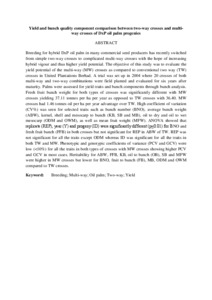Citation
Sritharan, Kandha and Subramaniam, Mohan and Arulandoo, Xaviar and Yusop, Mohd Rafii
(2017)
Yield and bunch quality component comparison between two-way crosses and multi-way crosses of DxP oil palm progenies.
Sains Malaysiana, 46 (9).
1587 - 1595.
ISSN 0026-6039
Abstract
Breeding for hybrid DxP oil palm in many commercial seed producers has recently switched from simple two-way crosses to complicated multi-way crosses with the hope of increasing hybrid vigour and thus higher yield potential. The objective of this study was to evaluate the yield potential of the multi-way (MW) crosses as compared to conventional two way (TW) crosses in United Plantations Berhad. A trial was set up in 2004 where 20 crosses of both multi-way and two-way combinations were field planted and evaluated for six years after maturity. Palms were assessed for yield traits and bunch components through bunch analysis. Fresh fruit bunch weight for both types of crosses was significantly different with MW crosses yielding 37.11 tonnes per ha per year as opposed to TW crosses with 36.40. MW crosses had 1.46 tonnes oil per ha per year advantage over TW. High coefficient of variation (CV%) was seen for selected traits such as bunch number (BNO), average bunch weight (ABW), kernel, shell and mesocarp to bunch (KB, SB and MB), oil to dry and oil to wet mesocarp (ODM and OWM), as well as mean fruit weight (MFW). ANOVA showed that replicate (REP), year (Y) and progeny (ID) were significantly different (p≤0.01) for BNO and fresh fruit bunch (FFB) in both crosses but not significant for REP in ABW of TW. REP was not significant for all the traits except ODM whereas ID was significant for all the traits in both TW and MW. Phenotypic and genotypic coefficients of variance (PCV and GCV) were low (<10%) for all the traits in both types of crosses with MW crosses showing higher PCV and GCV in most cases. Heritability for ABW, FFB, KB, oil to bunch (OB), SB and MFW were higher in MW crosses but lower for BNO, fruit to bunch (FB), MB, ODM and OWM compared to TW crosses.
Download File
![[img]](http://psasir.upm.edu.my/63735/1.hassmallThumbnailVersion/Yield%20and%20bunch%20quality%20component%20comparison%20between%20two-way%20crosses%20and%20multi-way%20crosses%20of%20DxP%20oil%20palm%20progenies.pdf)  Preview |
|
Text (Abstract)
Yield and bunch quality component comparison between two-way crosses and multi-way crosses of DxP oil palm progenies.pdf
Download (109kB)
| Preview
|
|
Additional Metadata
Actions (login required)
 |
View Item |

